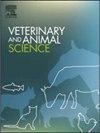利用随机森林回归、支持向量回归和分类回归树算法预测本地绵羊体重
IF 1.9
Q2 AGRICULTURE, DAIRY & ANIMAL SCIENCE
引用次数: 0
摘要
本研究旨在利用形态计量学特征建立埃塞俄比亚土着羊体重预测模型,并比较随机森林回归(RFR)、支持向量回归(SVR)和分类回归树(CART)算法的性能。收集了提gray地区Tahtay Maichew地区306只成年绵羊(249只母羊和57只公羊)的数据,包括体重和16个线性体测量(LBMs)。描述性统计显示,体重和主要腰体重存在低到中等程度的变异,其中心围(HG)和体长(BL)与体重的相关性最强(r分别为0.61和0.46)。在评估的模型中,RFR表现出优异的预测准确性,其R²值最高(训练时为0.809,验证时为0.477),均方根误差最低(训练时为1.650,验证时为2.825)。SVR在训练中表现良好,但在验证中泛化性较低,而CART在总体上表现最差。变量重要性分析发现HG是所有模型中影响最大的预测因子,在RFR中贡献40.90%,在SVR中贡献16.30%,在CART中贡献68.76%,其次是BL和肩高(HAW)。研究结果强调了RFR在资源有限且无法获得体重秤的情况下作为预测体重的强大工具的潜力。该研究为小农和育种计划提供了实用的见解,使遗传选择和管理实践能够基于易于测量的形态特征,特别是HG。未来的研究应该用更大、更多样化的数据集验证这些模型,以增强其在不同农业生态区和绵羊种群中的适用性。本文章由计算机程序翻译,如有差异,请以英文原文为准。

Prediction of body weight in indigenous sheep using random forest regression, support vector regression, and classification and regression trees algorithms
This study aimed to develop predictive models for estimating the body weight (BW) of indigenous sheep in Ethiopia using morphometric traits, comparing the performance of random forest regression (RFR), support vector regression (SVR), and classification and regression trees (CART) algorithms. Data were collected from 306 mature sheep (249 ewes and 57 rams) in Tahtay Maichew district of Tigray region, including BW and 16 linear body measurements (LBMs). Descriptive statistics indicated low to moderate variability in BW and key LBMs, with heart girth (HG) and body length (BL) showing the strongest correlations with BW (r = 0.61 and 0.46, respectively). Among the models evaluated, RFR demonstrated superior predictive accuracy, achieving the highest R² values (0.809 training, 0.477 validation) and the lowest root mean square error (RMSE: 1.650 training, 2.825 validation). SVR performed well in training but had lower generalizability in validation, while CART showed the weakest performance overall. Variable importance analysis identified HG as the most influential predictor across all models, contributing 40.90 % in RFR, 16.30 % in SVR, and 68.76 % in CART, often followed by BL and height at withers (HAW). The findings highlight the potential of RFR as a robust tool for BW prediction in resource-limited settings where weighing scales are unavailable. The study provides practical insights for smallholder farmers and breeding programs, enabling improved genetic selection and management practices based on easily measurable morphometric traits, particularly HG. Future research should validate these models with larger, more diverse datasets to enhance their applicability across different agroecological zones and sheep populations.
求助全文
通过发布文献求助,成功后即可免费获取论文全文。
去求助
来源期刊

Veterinary and Animal Science
Veterinary-Veterinary (all)
CiteScore
3.50
自引率
0.00%
发文量
43
审稿时长
47 days
 求助内容:
求助内容: 应助结果提醒方式:
应助结果提醒方式:


